Smart Governance: Solutions for Today's Global Economy
December 5, 2013
As prepared for delivery
Good afternoon! I am so pleased to be here with you today, where I spent very happy years earning my DPhil in economics. This is a magical place, full of beauty and clever people. My only regret is that I left too soon.
Fortunately, my good friends Ngaire Woods and Max Watson have invited me to return to give the Annual Global Economic Governance Lecture. Let me outline the main points I plan to make today.
Making the case for smart governance
Global economic crises tend to reignite discussions of global governance and international cooperation. The recent crisis has been no different. This is because crises lay bare the shortcomings of existing international rules and institutions.
We have seen how weaknesses and failures in banks and capital markets can spread through the international financial system. The same is true for other challenges faced by the world today, whether we are talking about climate change, nuclear weapons proliferation, or health pandemics. What happens anywhere affects everybody—and increasingly so.
So it is pretty clear that the world needs more, not less, international coordination and cooperation. But how to achieve this goal? In a recent article, the FT’s Martin Wolf discussed the importance of global public goods and how to provide them. “The states on which humanity depends to provide these goods, from security to management of climate, are unpopular, overstretched and at odds. We need to think about how to manage such a world. It is going to take extraordinary creativity.”
Martin is right. We need to be creative if we want to make progress. We need smart governance if we want solutions that work for today’s global economy.
I would like to focus today on three related topics. First, I will briefly touch upon the historical relationship between crises on the one hand, and governance reforms and policy coordination on the other hand. Second, I will discuss the response in terms of governance reforms and policy coordination that we have seen in the aftermath of the financial crisis of 2008. Finally, I will close my talk by sharing with you some reflections on how global economic governance might evolve going forward—how “smart governance” may provide the right balance between flexibility and effectiveness that the world needs to manage globalization.
A world in transition
The global economy is in transition. Global economic power is shifting from west, to east and south. Emerging and developing economies already make up more than 50 percent of global GDP (on a PPP basis)—ten years from now this number is expected to increase to 64 percent.
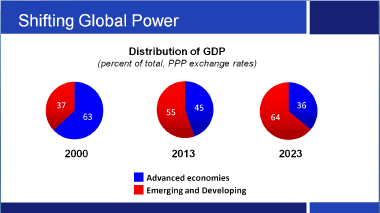
At the same time, trade and financial linkages have risen spectacularly. Cross-border bank claims grew from $6 to over $30 trillion between 1990 and 2008, and global merchandise exports of goods and services increased from $4 trillion to $20 trillion. While these numbers contracted somewhat in subsequent years due to the global crisis, the growth rates for the past 20 or 30 years are still impressive.
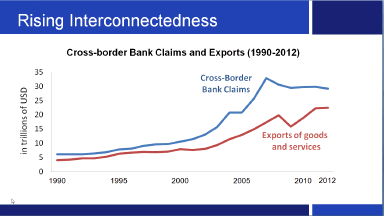
On the production side, global supply chains have become the norm rather than the exception. A typical manufacturing company today relies on inputs from more than 35 different contractors from around the world—for some companies, such as car and airplane manufacturers, this number can range in the tens of thousands.
With the sharp increase in interconnectedness and the growing diffusion of economic power, it would have been reasonable to expect a simultaneous transformation and expansion of global governance. In theory, demand for global governance should have increased with rising levels of global integration in order to manage the rules of the game and reduce negative spillover effects.
But as we all know, global governance issues were on the backburner in the run-up to the financial crisis. Indeed, against the background of high growth and low output volatility—what has been called “the Great Moderation”—observers even wondered whether global governance was a concept of the past, and institutions such as the IMF, World Bank and WTO superfluous.
Only in 2008, when a disruption in a relatively small segment of the U.S. financial system spilled into distant markets and countries, and morphed into a full-fledged global financial crisis, it became clear that there had been an undersupply of global governance in the years leading up to the crisis.
Crises as opportunity
Five years after the onslaught of the global financial crisis, economic governance remains at the center of the policy debate. I would argue that this is no surprise, given that, historically, there has been a symbiotic relationship between crises and the evolution of governance.
Granted, governance is often seen as evolving slowly and in an incremental manner and at a stately pace, while crises are intrinsically disruptive and revolutionary. However, as history has repeatedly shown, crisis often bring out the shortcomings of existing governance arrangements, while the fear of recurrence can galvanize support for reform.
For instance, in the wake of World War I, the League of Nations was created to promote international cooperation and achieve international peace and security, while experiences of hyperinflation in the 1920s motivated efforts to restore the gold standard. Similarly, the Great Depression and World War II triggered much of our current architecture of global governance, with the creation of the United Nations, IMF, World Bank, and the General Agreement on Tariffs and Trade, now the World Trade Organization. The traumatic experience of World War II also provided impetus for political and economic integration in Europe.
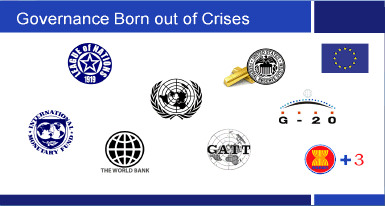
In the United States, the financial crisis of 1907 paved the way for the creation of the Federal Reserve, while the bitter experience of the Great Depression led to a major overhaul of financial regulation, with the passage of the Glass-Steagall Act in 1933, which separated commercial and investment banking, and remained in place for more than sixty years. More recently, the regional currency swap arrangements among ASEAN members known as Chiang Mai Initiative were created in the aftermath of the Asian crisis.
As with similar situations in the past, the global financial crisis of 2008 imposed large costs and hardship on affected countries. However, from a perspective of economic governance, it has also provided a window of opportunity to advance reforms and strengthen policy coordination. Did we manage to not let a good crisis go to waste? (a quote associated with Rahm Emanuel, President Obama’s former Chief of Staff, but like all great quotes was said by Churchill first). Let me provide a brief overview of what we have achieved in the past five years before looking at the gaps that remain.
A mixed score card
The efforts in governance reform since the crisis can be broadly split into three categories—coordinating macroeconomic policies, fixing global financial regulation, and strengthening regional and global safety nets.
First, macroeconomic policy coordination. Although not perfect, such coordination was particularly strong at the initial stage of the crisis. For instance, six major central banks announced, in an unprecedented move, a coordinated cut in policy rates in October 2008 to ease global economic conditions. The U.S Federal Reserve and 14 different monetary authorities established temporary U.S. currency swap arrangements to mitigate dollar shortages in short-term funding markets. And the first ever G20 Leaders’ Summit was convened in November 2008 and led to a commitment to coordinated fiscal stimulus and a pledge to refrain from protectionism.
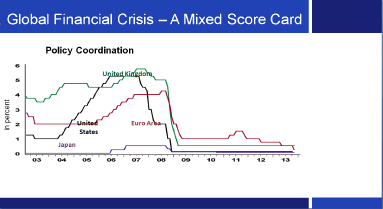
These massive efforts meant that, instead of another Great Depression, we got the Great Recession, which actually is a significant achievement, given the possible counterfactuals. However, more recently, the momentum for policy coordination has slowed, as the focus has shifted from preventing a calamity to avoiding future crises and supporting the nascent recovery. Some have argued that while the G20 was good in war, it might not be able to deliver as much in peace time.
And the task is far from over.
One challenge faced by the international community going forward will be to continue the dialogue on unwinding unconventional monetary policies and managing potential spillover effects as well as managing our way out of the debt burdens accumulated during the crisis.
Second, global financial regulation. To address the origins of the crisis, G20 members committed to a fundamental overhaul of global financial regulation, with the intention of promoting a more transparent, safe, and resilient global financial system.
Most notably, the Financial Stability Board (FSB) was created in 2009 with a mandate to develop and promote effective financial regulation. Significant progress has been made in terms of strengthening system-wide oversight, increasing capital and liquidity buffers, promoting the exchange of financial information, and implementing macroprudential policy frameworks. Efforts are also underway to facilitate cross-border resolution.
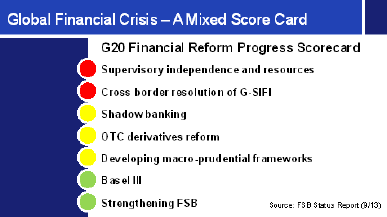
Yet major challenges remain, such as ending the too-big-to-fail problem, reforming shadow banking, and making derivatives markets safer. In the euro area, recent policy actions have helped ease market stress, but more still needs to be done to reverse financial fragmentation and move towards a full banking union.
Third, strengthening regional and global safety nets. To mitigate the impact of the crisis, countries came together to strengthen the global financial safety net, including by trebling the size of the IMF’s resources and increasing the allocation of SDRs. In Europe, the financial architecture of the euro area was enhanced through the creation of the European Stability Mechanism (ESM) and the ECB’s Outright Monetary Transactions (OMT) framework. In other parts of the world, commitments to regional financing arrangements, such as the Chang Mai Initiative and the Eurasian Economic Community Anti-crisis Fund, were reinforced.
However, progress has been uneven in other areas. For example, in the case of the IMF, the agreement reached in 2010 on important quota and governance reforms that would further increase the voice and representation of emerging market and developing economies has not yet been implemented. While two of three required conditions have been fulfilled, further support is needed to meet the final condition that will allow the reform to take effect.
If we put all this together, the report card on global governance reform since the crisis is somewhat mixed. Policymakers across the globe need to keep the momentum alive and seize the opportunity to advance governance reform while memories of the crisis and the sense of urgency remain fresh. Indeed, there is a real danger that the window of opportunity for addressing some of the most challenging global issues might soon be closing. How can this trend be reversed and important reforms finalized? To answer this question, it is helpful to look at the different types of solutions that have evolved as means to deliver global public goods.
Soft versus hard policy coordination
In what direction is the global system of economic governance and policy coordination evolving? To answer this question, I find it instructive to differentiate between “hard” and “soft” governance and policy coordination.
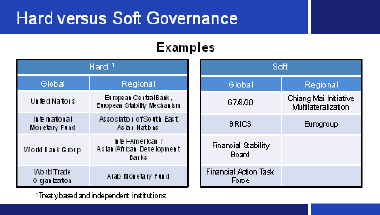
“Hard” policy coordination is typified by quid pro quos in policies with a focus on specific and tangible outcomes. Examples include the two initial G20 Leaders’ Summits that took place in the immediate aftermath of the crisis, and resulted in the coordinated fiscal policy response I mentioned earlier and the creation of the FSB.
In contrast, “softer” forms of coordination are more process-based without a priori expectation of substantial outcomes or agreements. They are designed to facilitate the exchange of views and information sharing on an ongoing basis, such as the regular discussions among central bankers at the Bank for International Settlements (BIS).
Soft and hard policy coordination can complement each other. For instance, soft arrangements can keep the policy dialogue alive during quiet times, and provide a framework for harder cooperation, and even full-fledged policy coordination, during crises.
Soft versus hard governance
A parallel argument can be made for governance. “Hard” governance arrangements require the establishment of legal obligations and independent institutions through treaties. The UN, IMF, World Bank and the WTO typify such arrangements.
On the positive side, this kind of hard, treaty-based architecture strengthens the credibility of member countries’ commitments and grants legal enforcement powers to institutions. However, their establishment and adaptation to changing circumstances tends to be a relatively slow-moving process, which can be a problem when the global environment or the needs of members change.
“Soft” governance arrangements, such as the G20 and BRIC country groupings, the FSB, or the Financial Action Task Force (FATF) have no international legal personality or obligations. As a result, they tend to be more flexible and can often be put in place more quickly. They do not, however, have treaty-based mandates or legal enforcement powers. As a result, they have a more limited ability to enforce commitments, which can pose challenges for their relevance and effectiveness over time.
Finally, there are, of course, also private sector solutions to governance challenges. One example are Collective Action Clauses (CACs) which allow a supermajority of bondholders to agree to changes in bond payments terms, with the intention of facilitating smoother debt restructuring. Another example is IFRS, an independent nonprofit foundation that promotes the harmonization of global accounting standards.
A mosaic of solutions
In sum, the global economic governance structure of the future may well be a mosaic—or ecosystem—of “hard” and “soft” elements that operate in a complementary fashion. In such a system, governance arrangements would essentially be issues- and context-driven, with choices between hard and soft governance arrangements depending on what is the most efficient and practical solution to regulate and oversee a specific matter at hand. Making such a system “smart” depends crucially on using hard or soft governance at the right time and for the right issues.
Let’s consider three examples of how hard and soft governance have been combined:
- First, take trade. We all prefer multilateral trade agreements over regional ones. Since the gains from trade are well recognized, the WTO dispute resolution process has real “teeth” with an ability to impose sanctions on those who violate global trade rules. Increasingly mega-regional agreements (like US-EU or TPP) are less about tariffs but about standards and non-tariff barriers. To the extent that they help set global norms that facilitate trade, they bring us closer to more global solutions and potentially reinforce (and in the future possibly become integrated with) the WTO framework.
- Second, consider the balance between hard and soft governance in the euro area crisis. Arguably the hard governance came from the IMF and the ECB and soft governance from the Eurogroup. Europe’s complex governance arrangements worked well in peace time, but decision making processes were not well suited to managing crisis.
- Finally consider the areas of financial regulation. As part of its mandatory Financial Sector Assessment Program (FSAP), the IMF conducts financial stability assessments every 5 years of jurisdictions that have systemically important financial sectors. Mandatory FSAPs are a good example of hard surveillance where countries are assessed against compliance with clear global standards and stress tested against national and international spillovers. Every two years after an FSAP, the FSB does a peer review (a sort of soft governance) of follow up on FSAP recommendations as a complementary way to advance key reforms for financial stability.
However, a flexible and efficient global governance structure may not emerge automatically. For example, when “hard” global institutions, such as the IMF, the World Bank, and the WTO adapt too slowly to changes in their environment, governance gaps will open up. “Softer” institutions may step in to fill these gaps, but as substitutes rather than playing a complementary role. This would not be efficient and could leave us with a weaker global governance system.
The case for IMF governance reform
This brings me to a final point. In the evolving ecosystem of global governance and policy coordination that I described, it is essential for the elements of “hard” governance to stay relevant by adapting to changes in the world economy.
Over the years, the IMF has demonstrated a remarkable ability to adjust its work and operations in response to major changes in the global economy, including the fall of the fixed exchange rate system in the early 1970s, the debt crisis of the 1980s, and the collapse of the Soviet Union in 1991.
The key reason why the IMF has remained relevant has been a political governance structure that, albeit slowly, does adapt to changes in the world economy. It also has an independent staff, and a constitution (in the form of our Articles of Agreement) that allows the Fund to adopt a longer-term perspective. Moreover, the IMF has, in some aspects, also managed to internally integrate hard elements of governance such as mandatory surveillance, with softer elements, such as voluntary Reports on the Observance of Standards and Codes or facilitation of standards for sovereign wealth funds. On the “softer” side, the Fund’s consensus-based decision-making has been effective at ensuring that member countries’ points of view are being heard.
Going forward, it will be crucial for the IMF’s effectiveness and legitimacy to ensure that its governance structure reflects the relative position of its member countries in the global economy. Approval of the 2010 reforms would be an important step in this direction, although further shifts in quota and voting shares to dynamic economies will also be needed.
To achieve this, some countries will have to accept relative declines in their quota and voting shares. Understandably, for them this will not be an easy decision, but in return they will help ensure that the Fund can continue to remain strong and legitimate for the benefit of the entire membership—and the global economy.
Conclusion
While significant efforts to improve global economic governance were made in the initial phase of the crisis, the momentum of reform and policy coordination has slowed recently.
Indeed, while the current system is able to deliver governance and policy coordination when there is a lot to lose—such as in a crisis, it is much less effective in galvanizing action when there is potential for mutual gain—such as global economic rebalancing.
One possible explanation is that the global community tends to rally in a time of crisis when the time horizon is short and immediate costs are high. However, in normal times, gathering momentum for action today may be hard because the cost of inaction lies far in the future.
Some observers point toward plurilateralism and the rise of soft global governance as a threat to the traditional pillars of hard global governance, including the IMF. I am much less pessimistic. I see these two forms of governance as potential complements rather than imperfect substitutes. Soft governance works when innovation is needed but there is time to act, when getting a subset of countries to act is sufficient and ad hoc implementation can work. Hard governance is needed in a crisis or when global approaches are needed and when consistent enforcement is key.
So, coming back full circle to Martin Wolf’s call for extraordinary creativity in seeking solutions to the multitude of challenges faced by the world today, I believe we can tackle the issues by being smart about the governance we need, and by making the most of political opportunity when it presents itself. By integrating “soft” and “hard” governance more intelligently, better outcomes can be achieved for everyone, small and large countries alike.i
i I am grateful to Andreas Bauer, Sanjaya Panth, Niklas Westelius, Camilla Andersen and Dustin Smith for their help in preparing this speech and to Olivier Blanchard, Sean Hagan, and Jose Viñals for their thoughtful comments.
IMF COMMUNICATIONS DEPARTMENT
| Public Affairs | Media Relations | |||
|---|---|---|---|---|
| E-mail: | publicaffairs@imf.org | E-mail: | media@imf.org | |
| Fax: | 202-623-6220 | Phone: | 202-623-7100 | |


